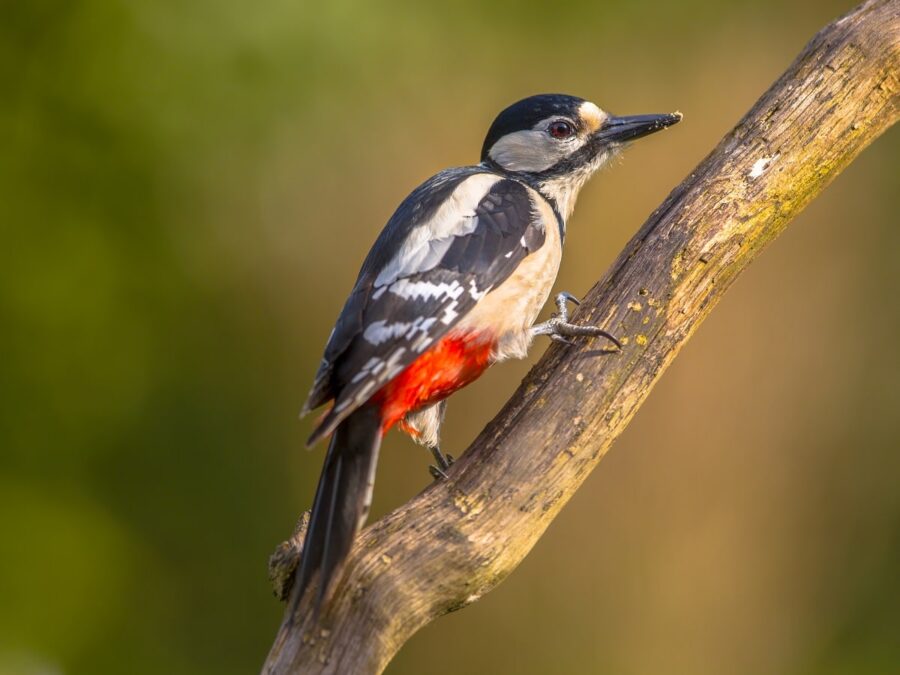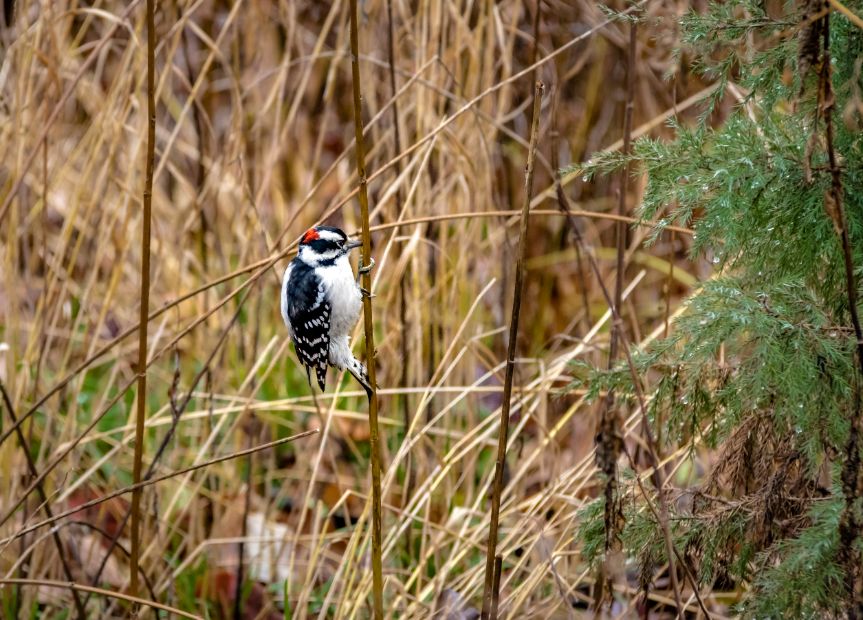Watching a woodpecker hammer away at a tree can be a fun way to spend an otherwise boring afternoon.
But have you ever paused to wonder why these birds spend a considerable amount of their time pounding on tree trunks and wooden surfaces? Or the extent of damage that their pecking behavior could cause if it were directed to your backyard trees?
This article uncovers the main reasons woodpeckers peck wood. We’ll also explain what you can do to keep woodpeckers out of your yard if you consider their pecking behavior too destructive or the noise a bit uncomfortable.
Table of Contents
Why Do Woodpeckers Peck Wood?
Woodpeckers peck rotting wood and dead or diseased tree bark for various reasons. Common ones include;
1. Establishing a Territory
All animals are territorial by nature. And a woodpecker is no exception.
Different animals have evolved diverse ways of marking their territories and displaying their dominance to potential rivals. In the case of a woodpecker, pecking on wood is a way the bird indicates who’s boss.
2. Excavating a Nesting Hole

Woodpeckers nest in tree trunks and other wooden surfaces. That explains how the bird might have gotten his name.
Therefore, pecking on wood could be an effort to excavate a safe and warm spot where the woodpecker can nest.
3. Finding Food
Another reason woodpeckers peck on wood is that they’re looking for food.
Woodpeckers mainly feed on insects, including adult insects as well as insect eggs and larvae. The birds particularly favor the larvae of carpenter bees, grass bagworms, and leafcutter bees. And they’re intelligent enough to know that their prey also like to nest on tree trunks and wooden surfaces.
Other insects commonly preyed upon by woodpeckers include beetles, caterpillars, and ants.
In addition to insects, woodpeckers are also fond of smaller invertebrates that live in or under tree barks. The birds may even consume plant-based foods, such as black oil sunflower seeds, peanuts, peanut butter, and millets. And when their food supplies diminish, woodpeckers will be happy to steal from hummingbird and oriole feeders.
Another interesting thing to note is that holes excavated for purposes of finding food tend to be smaller and more irregular than those made when seeking to nest.
4. Attracting Mates
Woodpeckers may also peck wood as a way of attracting potential mates. This usually happens when the birds go into the breeding season.
As with pecking for food, the holes woodpeckers make when pecking to attract sexual partners tend to be smaller and more irregular. However, the holes can cover an extensive area as the birds move about looking for receptive mates.
5. Sheer Curiosity and Natural Instincts
Some woodpeckers may peck out of sheer attraction or curiosity.
Perhaps the bird just moved into a new habitat and is trying to check out his newfound home. Or he’s just curious as to what lies beneath the wooden surface or tree bark.
In the same breath, some woodpeckers may peck out of anxiety and boredom. In this case, pecking provides the much-needed stimulation.
Why Does Pecking Seem So Easy For Woodpeckers?
Most birds have three forward-pointed toes and one hind toe. However, the woodpecker has two forward toes and two back toes. The bird is also endowed with relatively stiffened tail feathers. These evolutionary traits allow the woodpecker to hold firmly onto tree barks and peck without slipping. It doesn’t matter the orientation of a tree or wooden surface. A woodpecker can easily lean back and hammer away while maintaining his stamina.
Besides, woodpeckers have a unique muscle and tendon mechanism located behind their jaw. This mechanism absorbs shock, preventing damage to the bird’s cranial organs and bones. Some research indicates that woodpecker skulls can withstand 1200 g’s of force, which is 1200 the force of gravity.
But that’s not all. Woodpeckers also have modified feathers that extend to cover the top of their nostrils. These features, known as bristles, prevent the birds from inhaling wood chips while they’re pounding away. A useful feature considering that these iconic birds can make around 20 pecks per second.
Does Wood Pecking Have Any Benefits?
Pecking wood is not only useful for woodpeckers. The cavities created also provide nests and shelters for many other species who cannot make nests on their own. Examples include creepers, bluebirds, nuthatches, flycatchers, some swallow species, and even owls.
When a woodpecker makes a hole in a tree for purposes other than nesting, the bird will most likely abandon the cavity soon after making it. That allows these other animals to move in and claim the nest.
It’s also important to note that woodpeckers are generally indiscriminate regarding the objects they can peck. Although these birds are most famous for pecking dead or diseased trees, they’re also known to peck poles, fences, signposts, buildings, air conditioners, and even metallic surfaces.
How Do I Get Rid Of Woodpeckers From My Compound?

While wood pecking is beneficial for woodpeckers and many other animals, the action could speed up the death of important tree species. Besides, the pounding noise can prove too unbearable. Fortunately, there are several methods to remove these birds from your compound.
First off, you’ll need to determine that woodpeckers have infested your yard. And the best way to determine that is by checking for cavities on tree barks. Pay more attention to dead or diseased trees. After picking up sufficient evidence of woodpecker activity in your compound, you can proceed to implement any of the below tips;
• Create physical barriers around the pecking areas, such as erecting steel mesh
• Consider visual deterrents using brightly-colored objects, such as aluminum strips, pinwheels, and reflective tape
• Use noise to scare the birds away
Final Word
Woodpeckers peck for various reasons, including when looking for food, mates, and nests. However, the hammering action may prove harmful to certain tree species in addition to being distracting if it happens too close to your house.
That’s why you should consider getting rid of woodpeckers before they become a menace. Just remember to adopt safe removal techniques to avoid harming or killing these birds.

